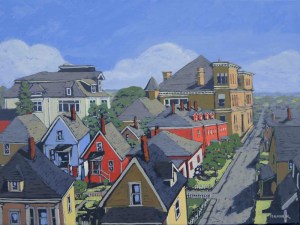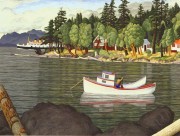When I discovered Michael Kluckner’s beautiful paintings of Vancouver, I wondered if the city’s Arts and Culture Policy Council had ever sent any funding his way.

Admiral Seymour schools in Vancouver’s Strathcona, by Michael Kluckner. From his book, Vanishing Vancouver: the Last 25 Years
It seemed unlikely, given that Kluckner makes the kind of art the average person enjoys. The city’s arbiters of culture, on the other hand, have a more rarefied taste.
Vancouver’s most recent public art project, the giant poodle by Montreal artist Gisele Amantea, is a case in point. The seven-foot figurine on Main and 18th Avenue has provoked bewilderment and frustration.
Why, some asked, did the city, TransLink and the federal government pay almost $100,000 to install this thing? And what exactly is it supposed to signify?
I called up Kluckner, and we chatted about just what makes the poodle so bad.
The poodle is an inside joke that allows certain people to feel superior–but it’s also an expression of empty consumer culture
“There’s an ironic hipster statement that is made by the poodle,” Kluckner said.
He compares the piece to Jeff Koons’ Puppy. Koons’s thing is to take kitschy objects and elevate them to high art. It’s meant to be a kind of clever joke.
“It’s a real wink, wink to a certain type of people: ‘you and I understand the point of this piece, but the average person won’t,’” Kluckner said.
The National Gallery of Canada Magazine interpreted the Poodle similarly (albeit more approvingly):
[The] poodle is a witty anti-monument that recalls older statues elevating goddesses, emperors and military heroes to the tops of lofty columns, as well as more common sights such as … huge doughnuts on the roofs of shops, or actual cars on poles at dealership parking lots, all for the sake of advertising.
It seems to me this kind of art has an antecedent in Andy Warhol, in the following sense: it’s an expression of commercial culture that embraces the emptiness of consumerism rather than attempting to lift us above it.
The very act of elevating kitsch to high art is a nihilistic gesture: it is a denial of the idea of high culture as such.
But high culture is what enables us to climb out of the cave of moment-to-moment existence; it’s what gives us insight into what it means to be human.
Tired old cliché
So the poodle is an inside joke. But how witty is that joke, really?
As aestheticist Roger Scruton points out, the ironic gesture is de rigueur among artists (at least the fashionable types). It started almost 100 years ago with Duchamp’s Fountain and has been repeated ever since.
The poodle, then, is trading on a cliché that “makes sheep look like free thinkers,” Kluckner said.
Okay, but does the poodle at least say something about local culture on Main Street? According to the Poodle’s creator, yes — er, sort of.
“The poodle is not associated with a particular culture, and can therefore be enjoyed by a wide range of people along the street,” Amantea said.
The sculpture represents “a porcelain figurine, the kind of object that might be found in any number of shops along Main Street,” she said.
Indeed. It’s the kind of mass-produced object that might be found in any number of shops on any number of streets around the world.
“[The Poodle] is kind of hip and fashionable,” Kluckner said, but it could just as well be “plopped down” in any hipster neighbourhood anywhere.
Who picks this stuff, anyway?
When I asked Kluckner if the city had ever commissioned him to make public art, the painter seemed somewhat surprised. He doesn’t really do “big outdoorsy” stuff, he said, adding:
“I’ve never really thought that I was part of that milieu.”
And just what is that milieu? What particular crowd of artists is given privileged access to our public space and supported with tax-payers’ money?
Artist Graeme Berglund is an example. He sits on the appointed, 15-member arts council, which reports to city hall. Here’s an example of Berglund’s work:
How many Vancouverites would put this morbid image in their living rooms? Not very many, I’m betting: it would be like putting an H.R. Giger piece above your bed.
This might lead one to wonder why an artist who seems to dwell on ugliness for its own sake has been appointed to recommend art for the public sphere.
Stay tuned. Next time I’ll look at the people and process that determine the kind of art that is put in our public places.



Hilarious, Kevin!! I never even thought of it like that. What a great idea to look into who decides what public art is to decorate our streets.
What do you think of the big raindrop and the lego-orca on both sides of the new Vancouver Convention Centre? Better than the poodle, I guess. Could you find out what they cost and who paid for them?
Katja
The Vancouver public art registry lists them as private developments, but the sponsoring organization seems to have been BC PavCo, which is a provincial Crown corporation. I’m not sure to what extent public funds would have been used.
Anyway, I think “The Drop ” is the least bad of the three, since it really doesn’t say anything at all. “Digital Orca” is juvenile. It’s as though the president of PavCo asked his 13-year-old to come up with an idea for a sculpture.
What do you think?
Much (okay, all I can think of) of Vancouver’s public art leaves me downright cold. The laughing men down at Denman and Davie. The walking pants at the skytrain. This poodle in my neighbourhood. Not unlike much of the rest of development and gentrification in this city, I find it very difficult to see myself and the city I’ve always called home reflected back at me. Discouraging.
It is upsetting, but I think a lot of people feel the same: if everyone voiced their discontent, and told their local politicians, things could probably change.
Kluckner mentioned the laughing men sculptures too. He said he finds them even worse than the poodle because of their mocking quality. I agree; there is something deeply cynical about them. Read up on the artist, Yue Minjun, and, sure enough, you find he’s part of a post-Tiananmen Square art movement called “Cynical Realism.” Its themes: disenchantment, malaise, materialism. The men are laughing out of despair.
Art is perceived personally, not group-forced. To me, it represents dogshit. So much of East Van is just shit. Low quality, over-hyped. Just trash. Seriously, anyone who does anything radical in their 20s either dies, moves away, or (too rarely) grows up into something meaningful through transformation. The majority of East Van people in their 30s, 40s, 50s, are still hanging on to the low-lifestyle they had in their 20s. Pity, really.